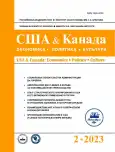Global top films: is there an alternative to Hollywood?
- 作者: Belova E.D.1
-
隶属关系:
- HSE University
- 期: 编号 2 (2023)
- 页面: 101-121
- 栏目: Culture
- URL: https://journals.rcsi.science/2686-6730/article/view/144787
- DOI: https://doi.org/10.31857/S2686673023020074
- EDN: https://elibrary.ru/PARSHO
- ID: 144787
如何引用文章
全文:
详细
参考
- Андреев А. Война за независимость. Рождение американской кинопромышленности. Сеанс. 2015. № 53/54. 1.03.2015.
- Артамонова У.З. Американский кинематограф как инструмент публичной дипломатии США. Анализ и прогноз. Журнал ИМЭМО РАН. 2020. №2. С. 110-122.
- Белова Е.Д. География мировой киноиндустрии как части креативной экономики и фактора развития других отраслей (на примере кинематографического туризма): автореферат дисс. канд. геогр. наук. М.: 2021. 24 с.
- Белова Е.Д. Кинематографический туризм в России. Вестник Московского университета. Серия 5: География. 2018. №3. С. 96-99.
- Белова Е.Д. Киноиндустрия стран Иберо-Америки: особенности региональной интеграции. Латинская Америка. 2022. №2. С. 79-91.
- Белова Е.Д. Территориальные различия в уровне развития киноиндустрии стран мира. Вестник Московского университета. Серия 5: География. 2018. №1. С. 57-65.
- Ермаков Д.Н., Казенков О.Ю. Американо-китайские отношения в условиях глобализации. США & Канада: экономика, политика, культура. 2022. №8. С. 102-124. doi: 10.31857/S2686673022080089
- Жабский М.И. Восхождение Голливуда к вершине конкурентоспособности в свете социологического дискурса Д. Прокопа. Вестник ВГИК. 2022. Т. 14. №1 (51). С. 76-86
- Жабский М.И., Тарасов К.А. Развлекательное насилие в кинодосуге учащейся молодёжи. Высшее образование в России. 2018. Т. 27. No4. С. 76-85.
- Замятина Н.Ю. Зона освоения (фронтир) и её образ в американской и русской культурах. Общественные науки и современность. 1998. № 5. С. 75-89.
- Фритц Б. Битва за прокат. Как легендарные франшизы убивают оригинальность в Голливуде. М.: Эксмо. 2011. 360 с.
- Халилов В.М. "Ярость белых мужчин": "Джокер" Тодда Филлипса и культурный цайтгайст (дух времени). США & Канада: экономика, политика, культура. 2020; 50(8): 97-114. doi: 10.31857/S268667300010631-4
- Хезмондалш Д. Культурные индустрии. Высшая Школа Экономики, М.: 2018. 455 с.
- Yin H., Sun Y. Analysis of China's Film Industry in 2020. Journal of Chinese Film Studies, vol. 1, no. 2, 2021, pp. 295-328.
- Berliner T. Hollywood aesthetic: Pleasure in American Cinema. Oxford University Press. 2017. 320 p
- Lukinbeal C. The Chinification of Hollywood: chinese consumption and the self-censorship of U.S. films through a case study of Transformers Age of Extintion. Erdkunde. 2019. Vol. 73. No. 2. Pp. 97-110
- McDonald P. Hollywood Stardom. Wiley-Blackwell. 2012. 352 p.
- Scott I. American Politics in Hollywood Film. Edinburgh University Press. 2011. 264 p.
- Williams G. The Story of Hollywoodland. Beachwood Canyon Neighborhood Association. Available at: https://web.archive.org/web/20140323064859/http://www.beachwoodcanyon.org:80/HISTORY.htm (accessed 28.08.2022).
补充文件








